Army Races To Rebuild Short-Range Air Defense: New Lasers, Vehicles, Units
Posted on
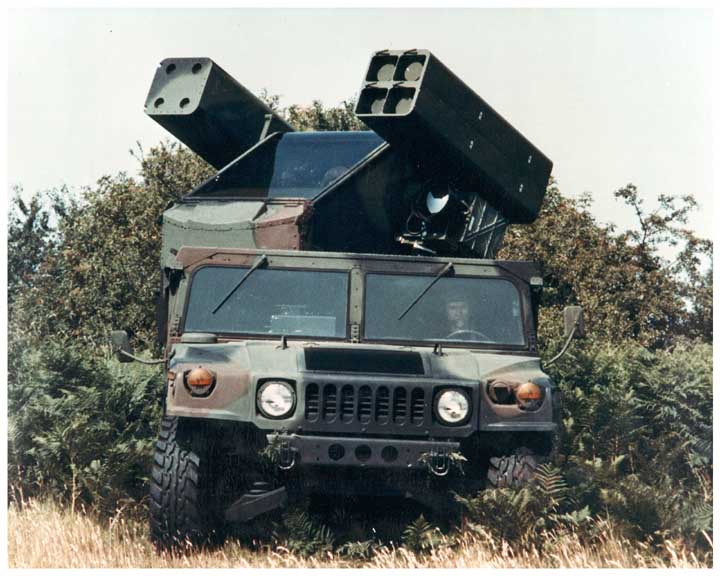
The Avenger mounts Stinger missiles on a Humvee — an increasingly insufficient combination for modern war.
ARLINGTON: As Russia and other adversaries stock up on drones, rockets, and missiles, the US Army is building up defenses to shoot them down. But that Short-Range Air Defense force has been devastated by a decade of cuts. The service’s plan to revive SHORAD involves
- deploying to Europe about 50 more of its current Avenger systems, Humvees mounting multiple Stinger missiles;
- developing requirements for new “Maneuver SHORAD” equipment — such as lasers mounted on armored vehicles to keep up with frontline units — for which an Initial Capabilities Document is expected out by April;
- and ultimately quadrupling the SHORAD force — if funding can be found — to put air defenders in every Army division and combat brigade, both active-duty and National Guard.
Adding these assets would allow frontline units to maneuver independently even in the face of air attack, a key part of the emerging Multi-Domain Battle doctrine. “Our ability to defeat air and missile defense threats would be central to that Multi-Domain Battle,” said Maj. Gen. Brian McKiernan, commander of the Army Fires Center at Fort Sill, which oversees both offensive artillery and air and missile defense.
There’s a real sense of urgency, said Col. Greg Brady, head of the Fires Division on the Army staff. “Within 12 months we have got to get capability back,”said Brady, speaking along with McKiernan at a recent Association of the US Army conference. “The No. 1 priority for capacity, the shortfall for the Army, is on air and missile defense.”
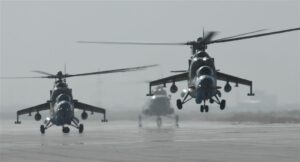
Russian-made Hind attack helicopters in Afghan service.
That’s particularly true in SHORAD, which is a distinctly different form of air and missile defense, and the one where the US is weakest. To combat long-range, high-flying ballistic missiles, the armed services have an array of complementary, overlapping, and extremely expensive systems, from the Ground-Based Interceptors (GBI) defending the US itself, to Terminal High-Altitude Air Defense (THAAD) and the Navy Standard Missile family, to the celebrated Patriot. To protect frontline units from low-flying threats, however, the Army relies almost entirely on Stinger missiles, both the shoulder-fired version made famous in Afghanistan and the Humvee-mounted version called Avenger.
The Army also has some ex-Navy gatling guns, ship defense systems converted to counter terrorist rockets and drones. Indeed, Counter-UAS (Unmanned Aerial Systems) has become a major effort. But with service leaders singling out Russia as the top threat, frontline Army units need air defense against the whole arsenal of a modern state: drones, yes, but also helicopter gunships, attack jets, rocket artillery, and even low-flying cruise missiles.
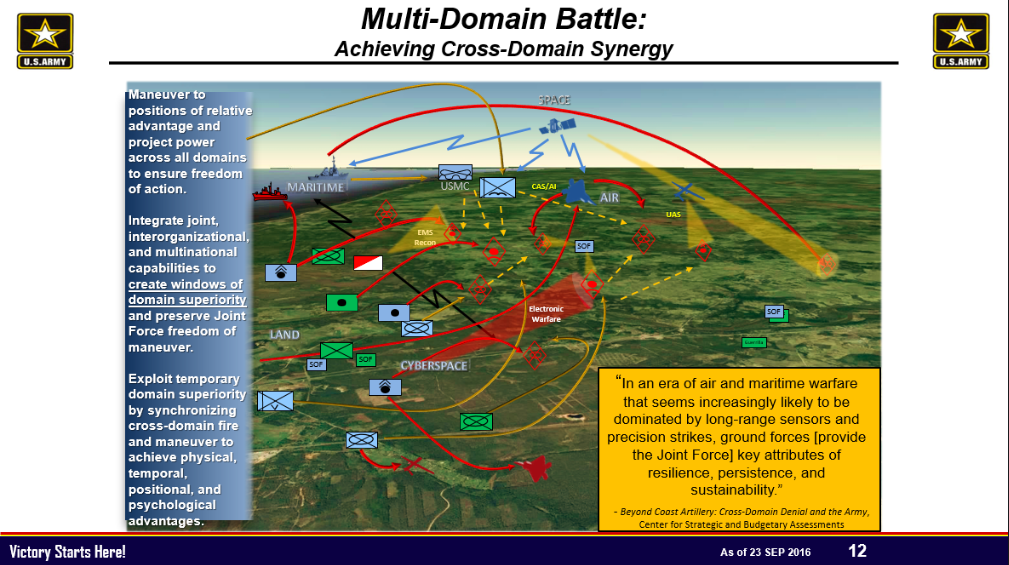
The Army’s Multi-Domain Battle concept for future war requires a new, more maneuverable form of air defense.
More Units, New Weapons
Back in the Cold War, the Army could meet this threat with a whole arsenal of air defense weapons. As late as 2004, there were 26 SHORAD battalions in the Army, said Brady. Today, it’s down to nine. Just two of them are regular active-duty units, the other seven in the National Guard.
That’s got to grow. “Our goal — I’m not sure we’ll achieve it — but our goal is to put a maneuver SHORAD battalion in every division and a battery in every BCT (Brigade Combat Team),” said Col. Edward O’Neill, the Capabilities Development and Integration director at the Army’s Fires Center on Fort Sill, Okla., speaking to the AUSA conference.
Fielding would start with the active-duty force, O’Neill explained to me afterwards, but the Fires Center recommends equipping the Army National Guard as well. Assuming the Army stays its current size — Trump and many in Congress want to increase it — that would be 18 battalions (for 10 active divisions and eight Guard) and 58 batteries (for 31 active brigades and 27 Guard). Those 58 batteries, at the traditional ratio of three batteries per battalion, add up to another 19 battalions’ worth. All told, compared to the current nine SHORAD battalions, the long-term aspiration — far from a funded plan — is for a four-fold increase.
“That’s a lot more air defense than we’ve had in the past,” acknowledged O’Neill, but with the Army’s new doctrine of widely dispersed, constantly maneuvering units, “you’ve got to be able operate semi-independently for a long extended period over time.”

Gen. Mark Milley addresses the Association of the US Army. At left is a restored M1 Garand rifle belonging to a fallen soldier from World War II.
The Army doesn’t just need more Short-Range Air Defense to do this, though. It also needs a new kind of SHORAD. The Multi-Domain Battle concept for future combat envisions a high-tech, highly lethal battlefield where forces must spread out and keep moving to avoid destruction. “On the future battlefield, if you stay in one place longer than two or three hours, you will be dead,” Army Chief of Staff Mark Milley warned another AUSA gathering last fall.
What does this mean for air defense? Instead of relying on big, stationary anti-aircraft batteries, maneuvering units must bring mobile air defenders with them. That’s why each division needs its own air defense battalion and each combat brigade needs its own SHORAD battery. Those batteries had better be able to keep up with their divisions and brigades as they go in harm’s way, which means the Army must develop what it’s calling “Maneuver SHORAD.”
Humvees with Stingers just won’t cut it: They lack both the protection and the off-road mobility required. “It’s got to be able to maneuver with our maneuver brothers (i.e. infantry and armor), so as they develop Mobile Protected Firepower or next-generation fighting vehicles…we’re really looking close at the Maneuver Center of Excellence and where they’re going (with) the chassis so we can incorporate that same platform,” O’Neill said.
While O’Neill didn’t specify a platform, it’s important to note that the Fort Benning, Ga. Maneuver Center works on armored fighting vehicles, not trucks. That implies the Army is looking to mount the future SHORAD systems on something like the eight-wheel drive Stryker, the tracked M2 Bradley, or the turretless utility version of the Bradley, the Armored Multi-Purpose Vehicle (AMPV).
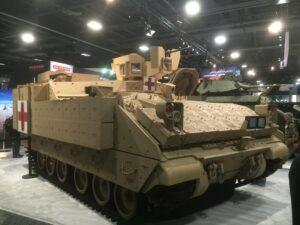
Armored Multi-Purpose Vehicle (AMPV) at AUSA.
These new vehicles would need to carry new weapons and new sensors to aim them by. “Here’s the problem: The sensors that are at the BCT (Brigade Combat Team) and below — there aren’t any,” said Col. Douglas White, Training & Doctrine Command‘s “capabilities manager” for air defense. “So we’re having to repurpose, multi-purpose is a better word, existing radars,” he told me, by upgrading existing counter-battery radars, designed to detect incoming artillery rounds, so they can pick up aircraft as well. Even so, White said, there are only six counter-battery radars per brigade, plus two Sentinel radars at division level which already can detect aircraft. That suggests more sensors are needed.
As for weapons, both lasers and high-powered microwaves are definitely on the table for the Maneuver SHORAD Initial Capabilities Document (ICD) now being reviewed, said Col. O’Neill. While such directed-energy weapons are in their infancy, they could keep firing as long as they have electrical power, making them an attractive alternative to limited supplies of expensive missiles like the Stinger, especially against large numbers of low-performance targets like drones and unguided rockets. An armored helicopter like the Russian Mi-24 Hind, however, might be too tough a target for lasers with today’s power levels. The best bet on the battlefield is a mix of complementary technologies, not a single silver bullet, so the Initial Capabilities Document is also looking hard at guns and missiles.
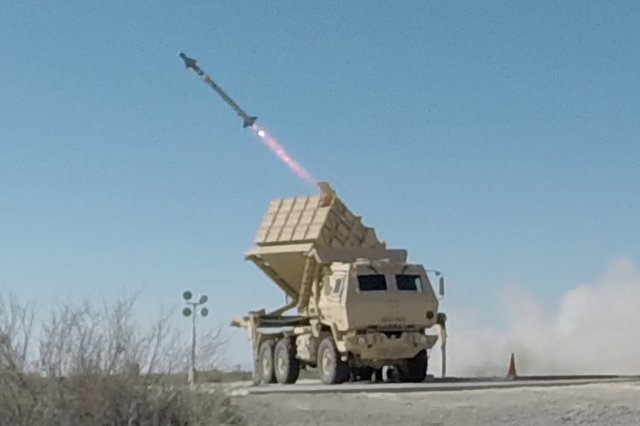
Army Indirect Fire Protection Capability (IFPC) test-fires an AIM-9X missile.
Coming Soon: IFPC & IBCS
In particular, “we need an ability to defeat cruise missiles short of firing a Patriot missile” — which is very expensive — “and better than firing a Stinger missile” — which is relatively short-ranged, said Brig. Gen. Christopher Spillman, who leads the 32nd Air & Missile Defense Command. The Army has had successful tests of the AIM-9X, originally fired by fighter jets but modified to launch from a ground-based system, the Indirect Fire Protection Capability. The basic, missile-armed IFPC will enter service ca. 2020, with future upgrades like lasers to follow.
IFPC will also use a new command-and-control network, the Integrated Air & Missile Defense Battle Control System (IBCS). This high-bandwidth network allow scattered batteries to fire off targeting data from a wide array of radars — that is, unless the enemy jams the transmissions.
IBCS will be “part” of the Maneuver SHORAD solution, but individual batteries need to be able to operate without it, Col. White told me. Even if the network keeps working, the sensors connected to it may not pick up low-flying targets: “Right now,” he said, “the first sensor that sees a UAS is the guy on the ground with the binoculars or his eyeballs…. or you hear them buzzing.” Or the target may simply fly across a battery’s field of view too fast to check in with higher headquarters before firing.
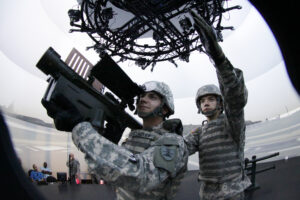
National Guard soldiers train with a Stinger anti-aircraft missile.
So future Maneuver SHORAD soldiers will need the authority and the training to open fire on their own initiative. “Centralized control, it doesn’t work,” White said. “In the experiments and exercises we’ve done, we’ve found that decentralized execution is the best way to go.”
That requires future air defenders with the self-confidence to shoot on imperfect data and the self-discipline to hold their fire when in too much doubt. As important as the technology will be, “it’s probably going to come down to tactics and training,” Lt. Gen. Michael Lundy, commander of the Combined Arms Center at Fort Leavenworth, told AUSA. “As an aviator,” Lundy added wryly, a helicopter pilot by training, “I certainly don’t want the air defenders not knowing what the hell they’re shooting at.”
But another speaker, retired colonel turned thinktanker David Johnson, downplayed the risk of friendly fire. Given how well enemy air defenses may keep our aircraft out, Johnson said, “frankly, in early stages of some of these conflicts, you won’t have to worry about shooting down blue air. It won’t be there.”
Subscribe to our newsletter
Promotions, new products and sales. Directly to your inbox.
